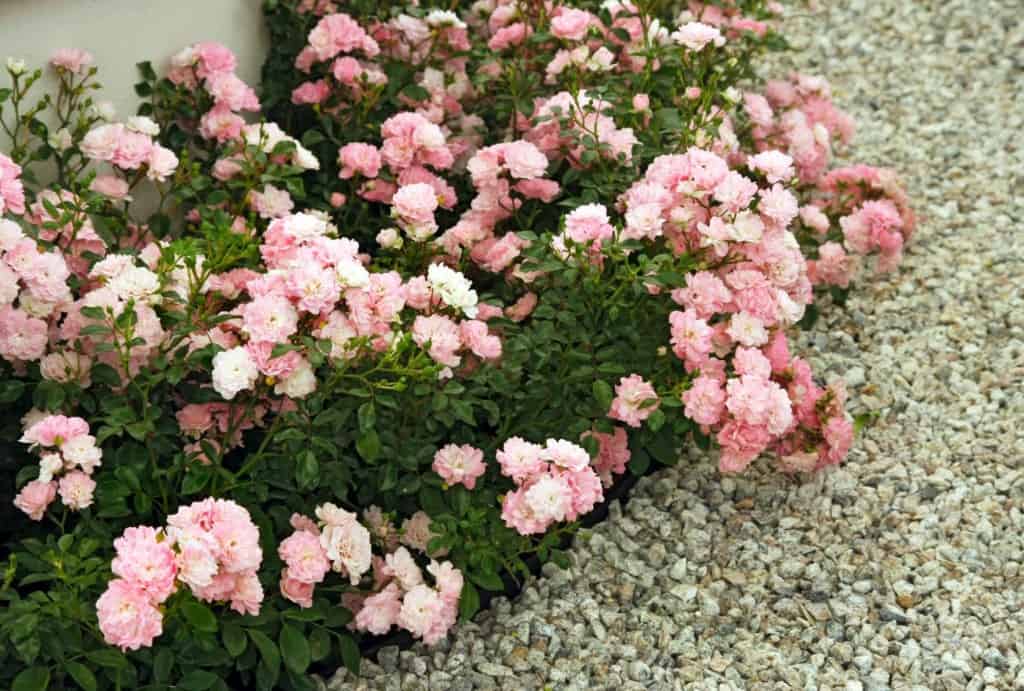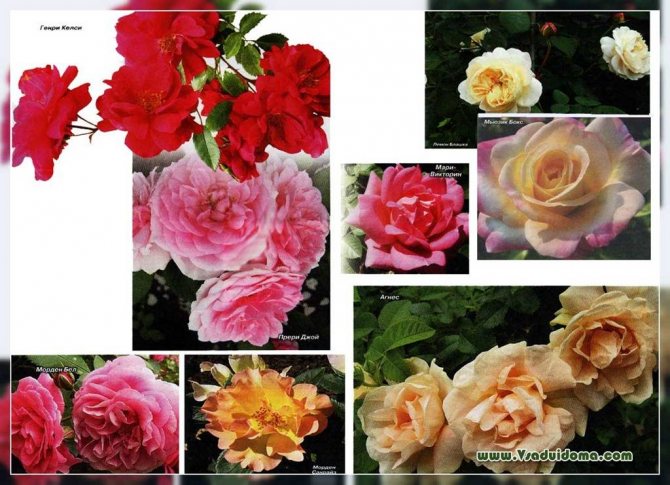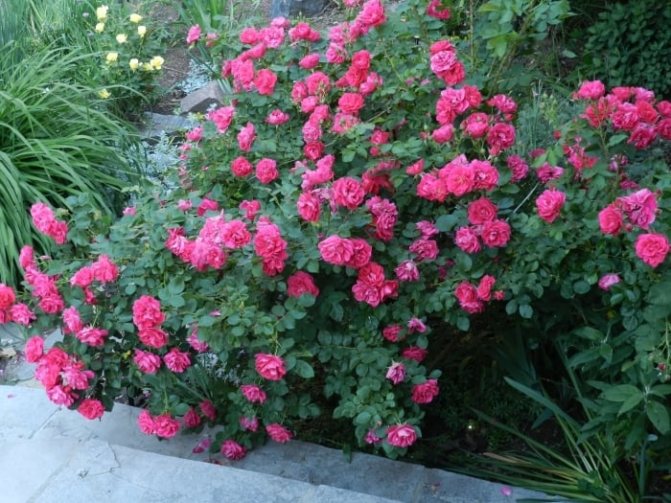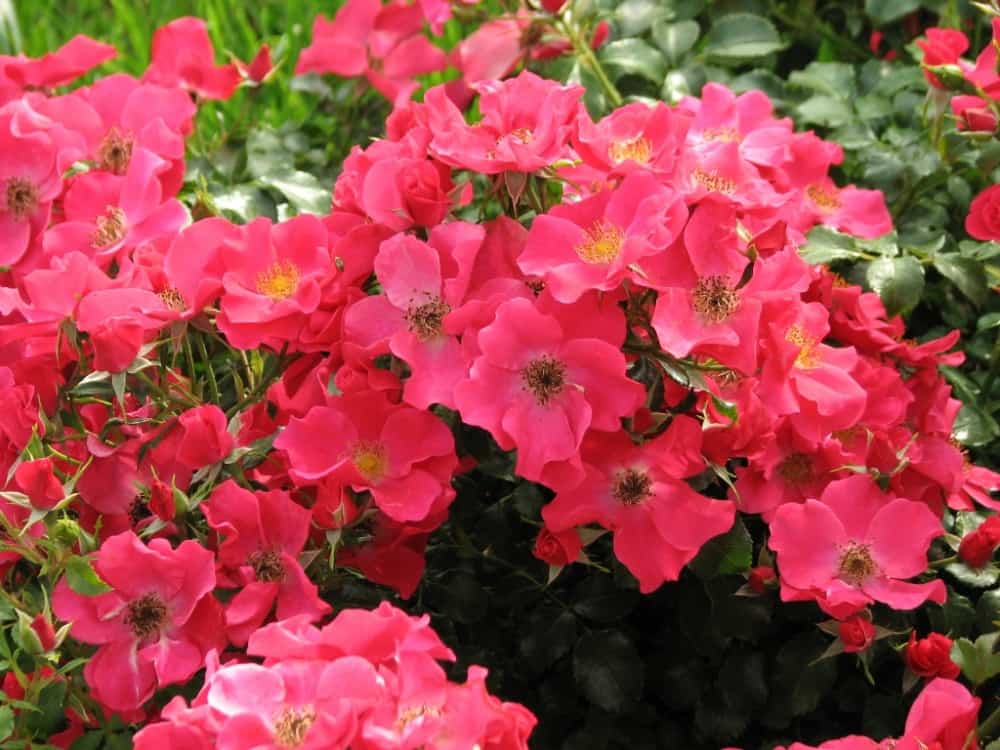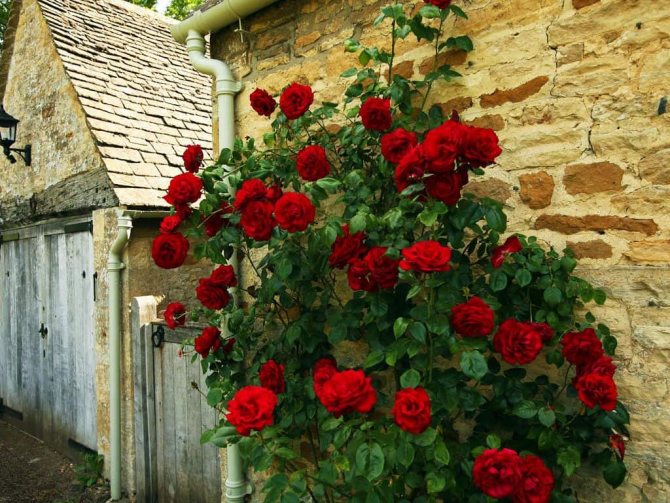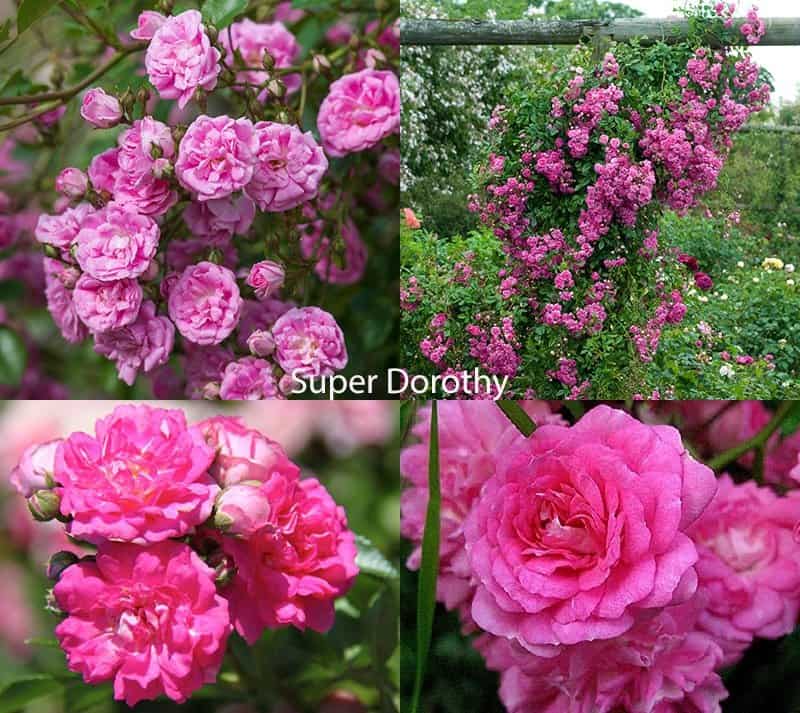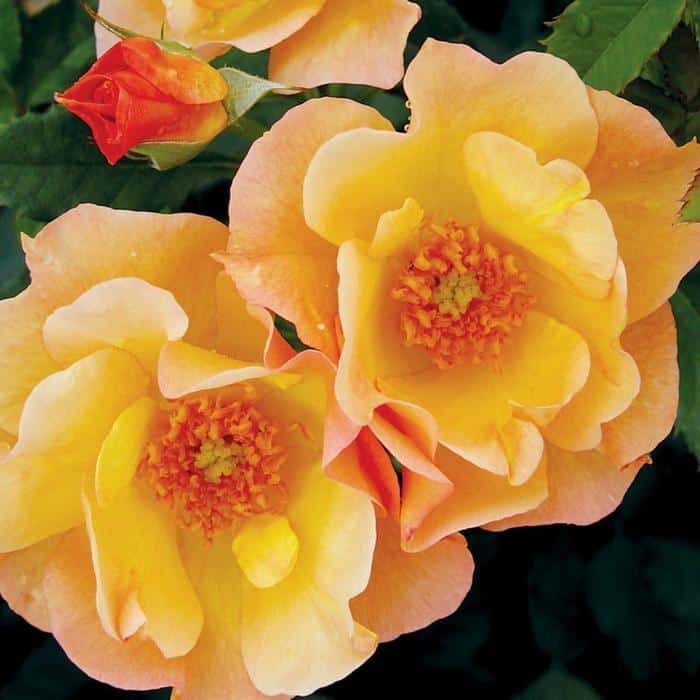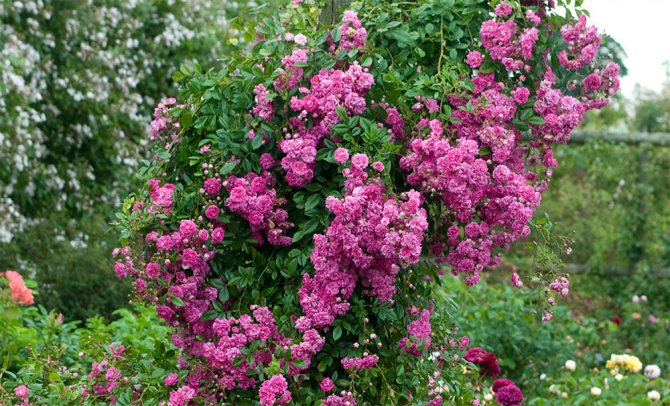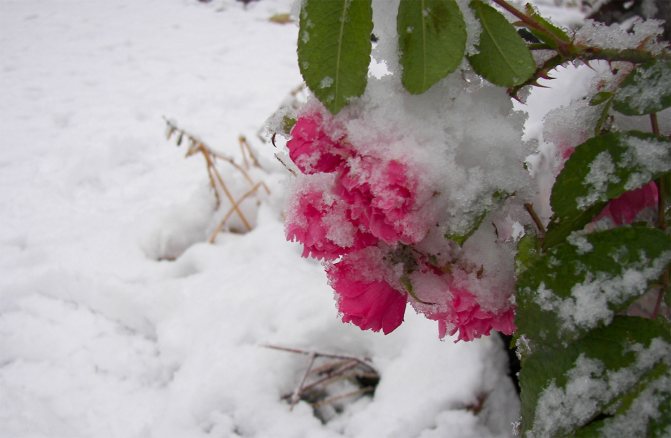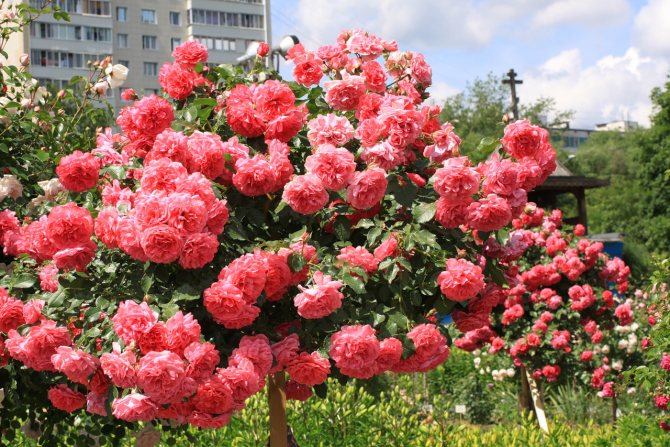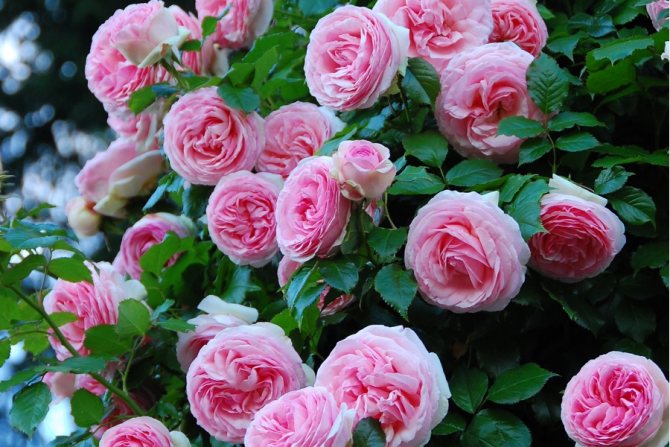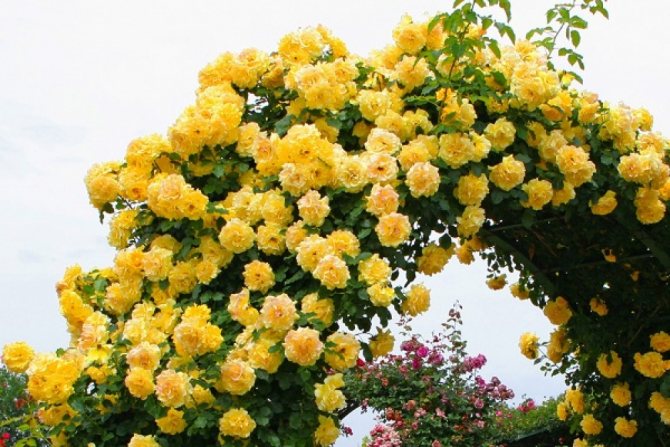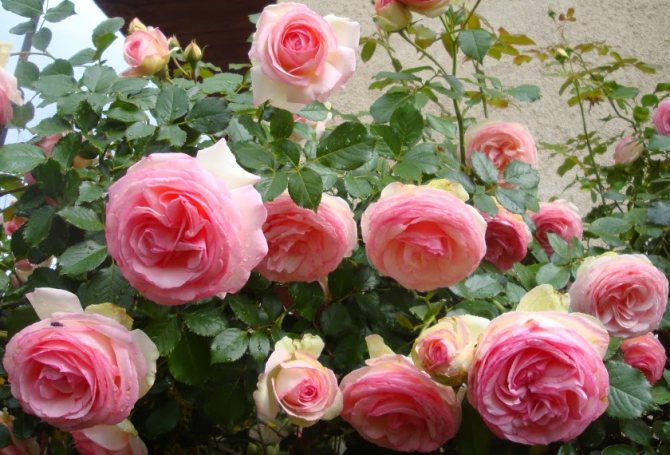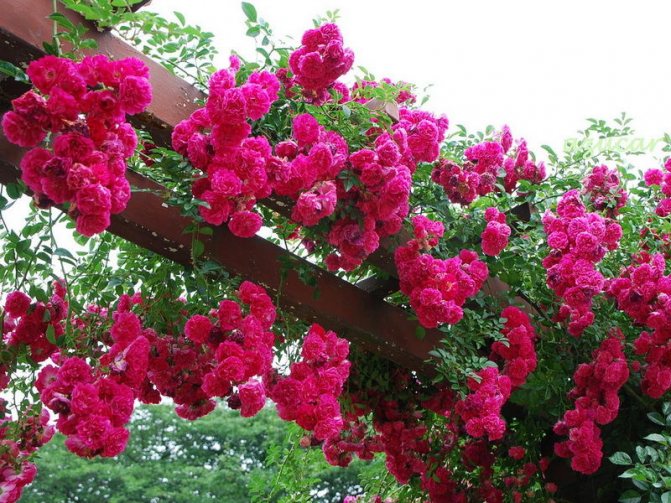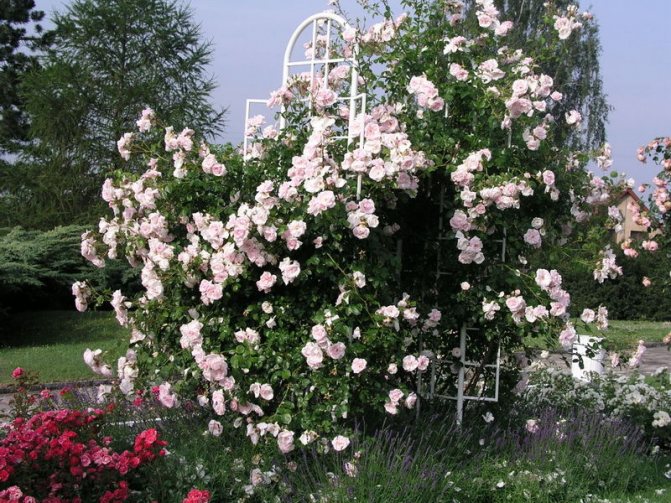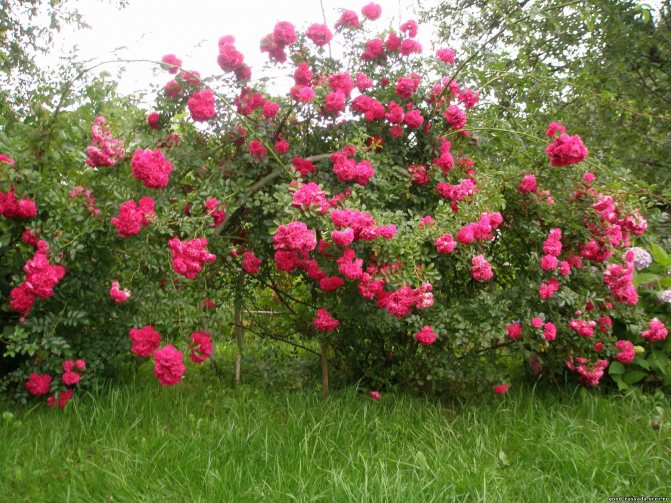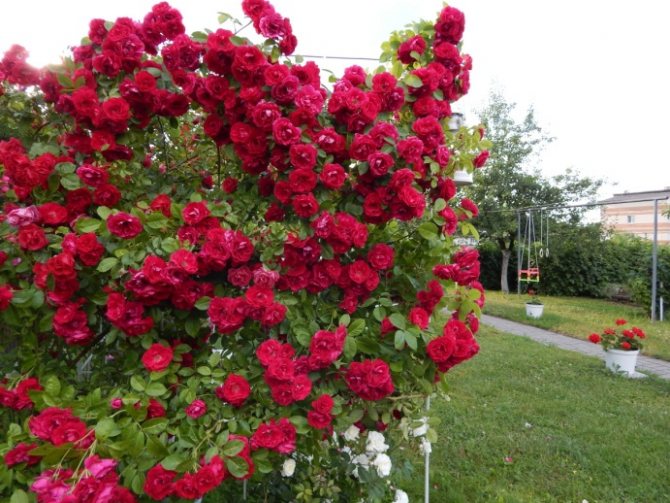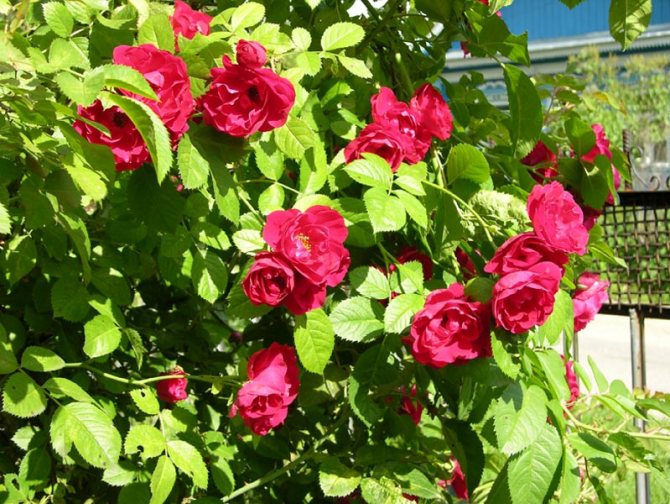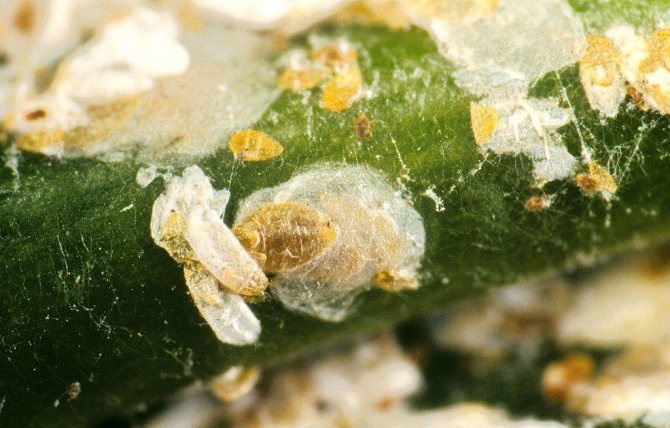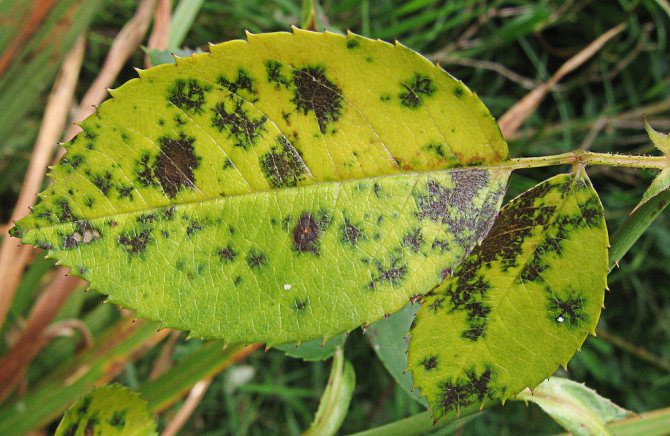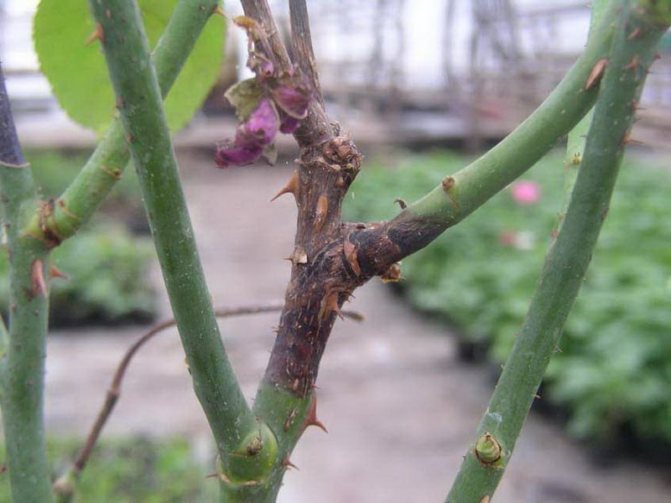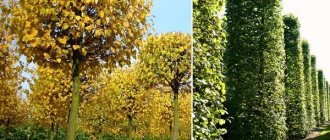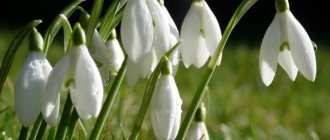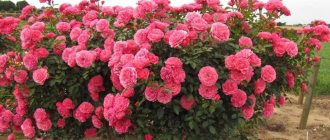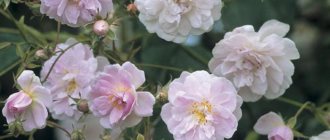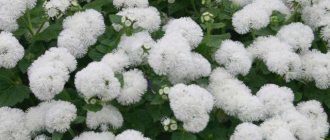The first who seriously thought about solving this problem was the German Rudolf Geschwind (1829-1910), who lived in Austria-Hungary. To increase the winter hardiness and resistance of roses to diseases, he began to attract wild species of roses from Siberia, North America, China and the Himalayas, from the highlands of Central Asia to crossing. He bred countless seedlings of varying degrees of decorativeness and stability. Only one hundredth of them have survived in historical rose gardens and private collections. But among the 140 surviving varieties, there are genuine pearls, and gradually some of them are becoming available on the modern flower market.
For the first time in Russia I.V. spoke about winter-hardy roses. Michurin
, and even there is a whole list of hybrids that he developed and described rather extensively, but none of them has survived to this day.
Reference by topic: How to plant roses correctly - we plant roses in a flower garden
However, no country in the world has spent so much effort to breed roses that can grow and bloom without shelter for the winter in a harsh climate like in Canada. Moreover, the Canadian government has funded a program to breed such roses for over 100 years.
RARE PLANT SEEDS FOR YOUR GARDEN - FREE SHIPPING. PRICES ARE VERY LOW. THERE ARE REVIEWS

The most winter-hardy varieties of hybrid tea roses
Often the description of these roses indicates their low winter hardiness and disease resistance. But there are hybrid tea roses that are in no way inferior in winter hardiness to other groups of roses. Nevertheless, in the middle lane, where snowless cold winters and unexpected thaws are possible, followed by severe frosts, all hybrid tea roses need shelter for the winter.
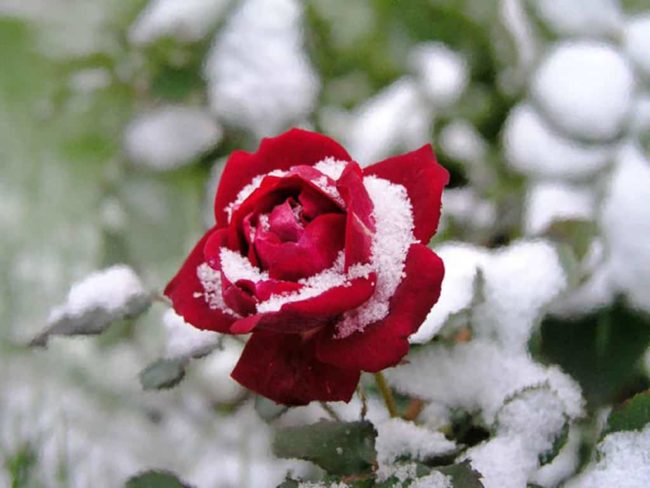

Parole (Parole, W. Kordes Sohne) - it's just a masterpiece among roses! The bud is a large tall glass of dark crimson color. Flower diameter 15 cm. It has a strong aroma. The bush is erect, vigorous. The foliage is glossy dark green. Blooms profusely all summer. The height of the bush is 80–90 cm. Disease resistance is high. The variety is frost-resistant.
Grand Amore (W. Kordes Sohne) - one of the most resistant red hybrid tea roses, tolerates heat and stands beautifully in a vase. Classic tall glass. Does not fade in the sun. Blooms profusely all summer. The variety is winter-hardy, resistant to adverse weather conditions, black spot and powdery mildew. The height of the bush is 80 cm.
Gloria Day, Meilland - a rose of extraordinary color - from light yellow with a beige tint to copper-pink. Blooms profusely all summer. The variety is resistant to disease. Winter hardy. The height of the bush is 80 cm.
Memori (Memoire, W. Kordes Sohne) Is a snow-white rose with a very large goblet-shaped bud. Long flowering. The variety is resistant to adverse weather conditions (very hot or rainy summers), black spot and powdery mildew. Although this rose is moderately hardy (the upper parts of the shoots freeze over), it is worth growing for the largest and longest flowering white flowers. The height of the bush is 70 cm.
Nostalgie (Nostalgie, Tantau) - a beautiful rose with a cup-shaped double bud of white color and a red border. Resistant to adverse weather conditions (very hot or rainy summers). Blooms almost continuously all summer. The variety is resistant to black spot. Frost resistant. The bush is vigorous and compact, up to 100 cm high.
Eliza (W. Kordes Sohne) - pale pink bud with a pearlescent shade. The blossoming flowers are very beautiful, double, large, with a light fruity aroma. Suitable for cutting. Height 90–100 cm. Compact bush with dark green foliage. The variety is resistant to disease. Frost resistant.
Burgund 81 (Burgund 81, W. Kordes Sohne) - one of the best red hybrid tea roses. Very large bud, 12 cm in diameter. Blooms all summer. Suitable for cutting. Resistant to adverse weather conditions (hot or rainy summers), black spot and powdery mildew. Winter-hardy variety. The height of the bush is 100 cm.
Beverly (W. Kordes Sohne) - a tall glass of bright pink shade and pale pink outer petals. Large double bud with rich aroma. Blooms profusely all summer. Suitable for cutting. The height of the bush is 70–80 cm. The variety is resistant to black spot. Frost resistant.
Sebastian Kneeipp, W. Kordes Sohne - an extraordinary hybrid tea rose with a double cup-shaped bud. This rose blooms in large inflorescences. The flower is creamy white with a yellowish-pink color, 10–11 cm in diameter. The variety is resistant to adverse weather conditions (hot or rainy summers), black spot and powdery mildew. Frost resistant.
Marvel (Marvelle, W. Kordes Sohne) - eye-catching striped flowers that are great for cutting. Red, yellow and orange stripes complement each other beautifully in this unusual bud with a diameter of 10 cm. Blooms all summer. The variety is resistant to black spot and powdery mildew. Frost resistant. The height of the bush is 80 cm.
Kupferkönigin, W. Kordes Sohne Is a very resistant variety with a bright yellow bud. Classic tall glass. Does not fade in the sun. Suitable for cutting. The variety is resistant to black spot and powdery mildew. Frost resistant. The height of the bush is 80 cm.
La Perla (W. Kordes Sohne) - one of the most resistant light roses, tolerates heat and stands perfectly in a vase. Bud is a classic tall ivory goblet. Does not fade in the sun. Blooms profusely all summer. The variety is winter hardy, resistant to adverse weather conditions, black spot and powdery mildew. The height of the bush is 80 cm.
Luck of Cordes
- ‘Flammentanz’
This climbing rose, bred in 1955, was considered by its originator Wilhelm Cordes to be his best creation. And quite rightly so. Winter-hardy and hardy, immune to disease, capable of delighting with its lush flowering for more than a month. It blooms profusely with bright red flowers with a scarlet sheen, collected in bouquets of inflorescences of 5-7 pcs.
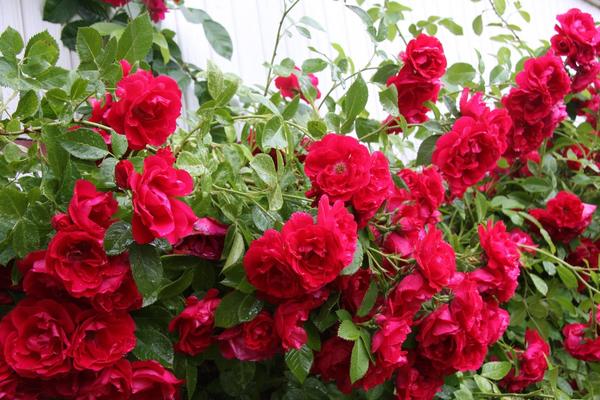

Climbing rose 'Flammentanz'.
In the garden classification of roses it occupies a special, only her place. Refers to once flowering, but it cannot be considered a classic rambler. It does not need to remove faded shoots, as they will bloom again next year. Quite easily fits under the shelter and confidently endures even the most severe frosts. It is noticed that it lives longer as its own rooted one, therefore it is better to propagate it by cuttings.
- ‘Westerland’
Amazing scrub 1969, a uniquely beautiful rose with bright semi-double cupped flowers. The complex color during blooming changes from fiery orange to salmon pink. The golden yellow center of the flower glows from the inside. The edges of the petals are wavy, which gives the rose grace and unique charm. The foliage is large, leathery, dark green, immune to disease. It blooms almost without interruption all season and winters well. Extremely fragrant!
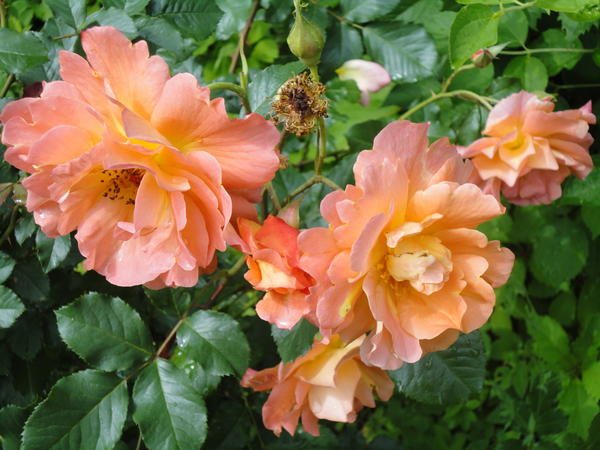

Rose 'Westerland'. It is a great success to have this outstanding variety in the garden!
- ‘Rosarium Uetersen '
A lush blooming rose, bred in 1977, with large, densely doubled (each flower has up to 100 petals and a tiled structure), bright pink flowers with a silvery bloom, collected in heavy drooping brushes. Leaves are glossy, disease resistant.Sprawling bushes with whip-like shoots. It is famous for its abundant flowering before frost. Creates a bright accent in the garden.
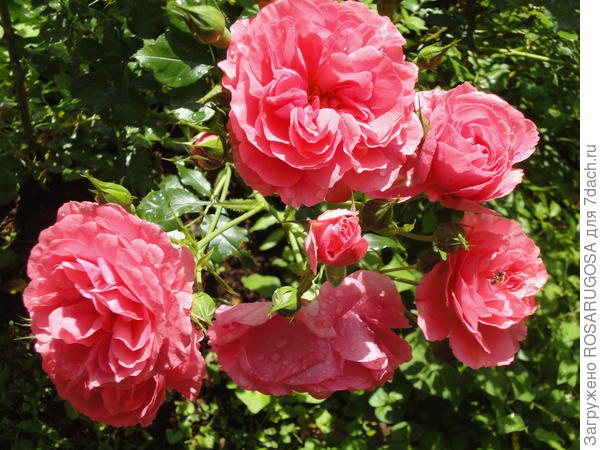

The bright flowers of the 'Rosarium Utersen' are eye-catching.
- ‘Angela’
A bright representative of the romantic trend in the selection of roses, is now at the peak of popularity, although it was introduced to the world of gardeners back in 1984. It blooms with caps of small carmine-red bowl-shaped flowers with a pale pink center. Not afraid of heat or rain. A beautifully leafy bush up to 1.5 m high resembles a pink cloud. It grows in breadth. Good in solitary fit. Smells fresh and green apple. This wonderful floribunda produces 3 waves of bloom. A pleasant bonus of the variety is healthy, shiny and elegant foliage.
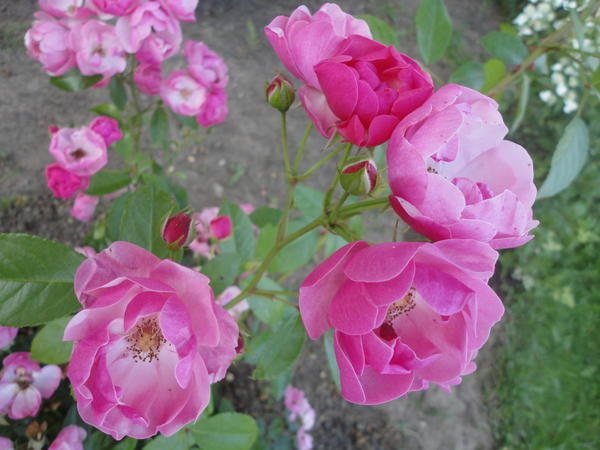

‘Angela’ is a vivid representative of the romantic direction in the selection of roses.
Cutting roses
Roses are cut in the phase of a colored bud with bent sepals, and densely double varieties in the stage of a "loose" bud, when the lower petals begin to open. Do not cut closed dense buds, they may not open in a vase and wilt. In order not to damage the moisture-conducting vessels, it is better to cut the flowers with a sharp secateurs. Scissors crush the shoots and deform them.
It is advisable to cut roses early in the morning or late in the evening, best of all in cloudy weather - at this time the moisture reserve in the plant is maximum. It is not recommended to cut flowers in the heat, because they quickly evaporate moisture and wither.
It is better to take water for cut flowers that is settled and change it daily, rinse the stems with running water, regularly updating the cuts. Roses do not tolerate direct sunlight, drafts and hot rooms, so it is better to put vases with roses in a cool, slightly darkened place.
Requirements for varieties of roses for growing in the Leningrad region
Taking into account the climatic and soil characteristics of the region, it is possible to formulate the basic requirements for varieties of roses that would be suitable for growing in the Leningrad region:
| Variety requirement | Justification |
| Damp-off resistance | Unstable winters with frequent thaws. |
| Resistant to fungal diseases and root rot | Frequent rain and fog. |
| Shade tolerance | Few sunny days, predominance of cloudy weather |
| Flower resistance to rain | Prolonged summer rains with strong gusts of wind |
It is possible to increase the resistance of varieties to unfavorable conditions with the help of a number of agrotechnical methods:
- landing on elevations, artificial slides;
- landing at the southern walls of buildings in unshaded places;
- partial replacement of soil during planting;
- regular feeding with complex fertilizers;
- regular introduction of humus into the trunks;
- regular formative pruning of bushes, which does not allow thickening;
- the use of "dry" mulch - bark, coniferous litter, coconut fiber.
It is not necessary to completely abandon mulching, fearing waterlogging of the root collar. Mulching protects the shoots of the rose from being damaged by fungal spores rising from the soil. However, you should not use mulch prone to caking, dampness and decay (grass, sawdust, etc.).
Tip # 1. In damp climates with frequent rains, mulching with non-woven materials works well. For the soils of the Leningrad Region, a leaching regime is characteristic, and agrofibre mulch partially retains excess moisture, passing it in dosed. In addition, it allows air to pass through well, contributing to normal aeration of the base of the bush.
Preparing roses for winter
Hiding roses is a simple job, but it requires some consistency and clarity of execution. Roses should be covered when there is constant frost, usually in November. If you cover the roses earlier, the shoots will not be ripe enough, with too soft wood. Light frosts in early autumn not only do not harm the roses, but also increase their endurance.
It is necessary to remove the entire unripe part of the bush - cut off young shoots and parts of shoots that did not have time to woody. Trim the leaves, leaving petioles about 1 cm long. The removed foliage is best discarded or burned. It is not suitable for compost as it can be contaminated with black leaf spots, for example. Tie the stems into a loose bundle and treat with a 3% solution of ferrous sulfate.
Cover the base of the bush with dry earth to a height of 15–20 cm at the rate of 1 bucket of earth per bush. Peat is unsuitable for this, it is highly saturated with moisture and completely freezes in winter, creating a shell under which the rose vomits.
Sand, too, can only be used as an additive to dry soil. Cover the roses with spruce branches or non-woven covering material (lutrasil) of white color, 60 mm thick in 2 layers.
Frost-resistant roses, cultivation history
Today, no one can say for certain when the rose was first cultivated. Even ancient Chinese healers began to use rose oil as a medicinal, perfumery and cosmetic product. And they covered the imperial path with petals when he left the palace.
The tombs of the ancient Egyptian pharaohs are decorated with images of roses. Noble citizens of Ancient Rome decorated the walls of their houses with the image of a rose.
Medieval knights used roses as a symbol on family crests. The English royal dynasties considered the rose as their ancestral flower: Lancaster - scarlet rose, Yorkie - white.
In Russian gardens, the rose settled under Peter the Great, who ordered the planting of roses in the palace gardens of Moscow and St. Petersburg. And Catherine the Great ordered the laying of the first rose garden in the Moscow Kremlin.
The first varieties of frost-resistant roses of domestic selection were registered in the last quarter of the last century.
Pruning roses
The two most important pruning in the life of a hybrid tea rose:
- after planting - the formation of the crown of the bush during the first year of life on the site;
- in the spring, after the opening of roses - if the crown of the bush is not lush and beautiful enough, or in case of loss of part of the shoots after wintering.
The rest of the pruning is cosmetic - removal of faded flowers, diseased or broken shoots. After August 1, it is very important to cut the fattening shoots in half, so that the lower part of the shoot can ripen and woody before the onset of frost.
Review of greenhouse roses for the Leningrad region
Petersburg rose growers who have a year-round heated rose garden can be advised the following greenhouse varieties of roses:
| Variety name | Short description |
Gaujard
Black Baccara "Black Baccarat"
Casanova "Casanova"
Pascali
When growing roses in a greenhouse, it must be remembered that not all varieties are equally well tolerated in the absence of full-fledged sunlight. You need to choose only those that are suitable for artificial winter lighting.
To prevent roses from “burning” in the greenhouse in summer, they need to be lightly shaded with a net and well ventilated.
Top dressing and planting roses
Top dressing of roses is carried out from May to July every two weeks, alternating organic and complex mineral fertilizers. From August 1, it is necessary to stop the application of nitrogen-containing fertilizers, and introduce potassium and phosphorus fertilizers - for the timely ripening of young shoots and slowing down the abundant sap flow in the shoot tissues.
The best time to plant roses is spring (May to June) and autumn (September to October). It is better to do this in cloudy weather. It is necessary to look for a place for the rose garden in advance.
The land must be fertile. Roses feel good in the sun, and some varieties - in partial shade. If groundwater is close, then drainage should be laid at the bottom of the planting pit.
Features of the climatic conditions of the Leningrad region
The climate is one of the determining factors in the cultivation of such a capricious culture as a rose. In the Leningrad region, it is characterized by the following features:
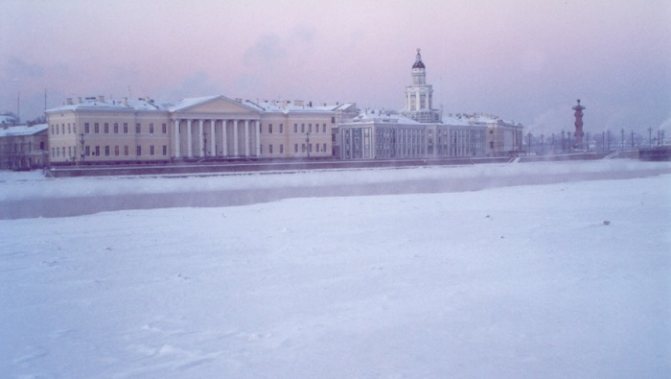

Rose varieties for growing in the Leningrad region.Low insolation, high humidity and heavy rainfall are the main features of the Petersburg climate.
- a small amount of solar heat, due to the proximity of the region to high northern latitudes;
- high air humidity and constant circulation of humid sea air from the Atlantic, which softens the climate;
- a very large number of cloudy days;
- large amount of precipitation, frequent fogs;
- mild winters with an average temperature in January-February of -6-7 0 С;
- small amplitude of fluctuations between average summer and average winter temperatures.
The climate of the Leningrad Region is famous for its inconstancy, which is caused by the constant influence of Atlantic cyclones and anticyclones. The process of global warming is also making its own adjustments. Therefore, despite the proximity of the north, the vicinity of St. Petersburg can be attributed to V or even VI zone USDA frost resistance.
Category: "Questions and Answers"
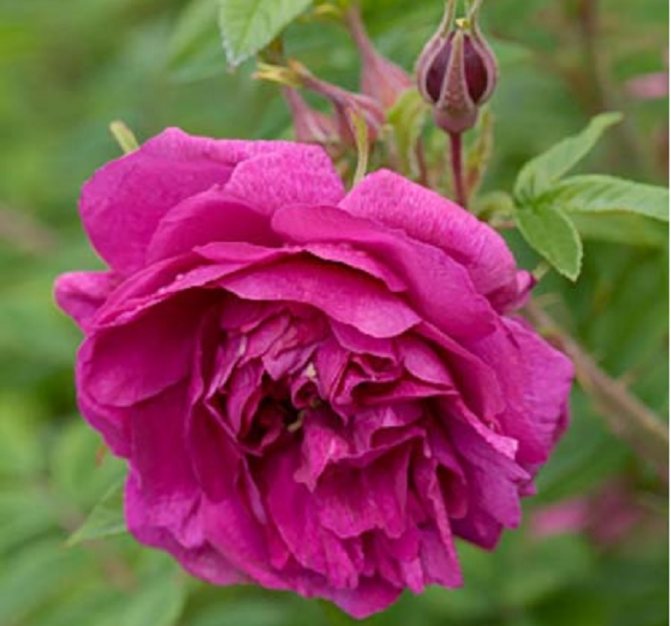

The "Queen of the North" variety was bred by the famous gardener E. Regel in 1879.
Question number 1. How does soil type affect the wintering rate of roses?
In the most direct way. The speed of freezing and thawing of the soil depends on the structure of the soil. Sudden changes in the temperature of sandy soil have a negative effect on the roots of roses. Excessively moist clay soil displaces air, and the roots suffocate. And for full development, they need oxygen throughout the year, because the root system continues to grow in winter.
Question number 2. What is better to choose from imported or domestic varieties of non-covering roses?
Irrelevant. Domestic nurseries grow many foreign hybrids. It is important to choose a variety that is suitable for the climatic zone where your garden plot is located.
If you are not sure about foreign roses, you can turn to varieties that have been tested not only by the climate, but also by the time. For example, the famous Russian variety “Tsaritsa Severa”.
Things to Remember
- Choose a frost-resistant look... Climbing and ground cover roses are suitable for any weather conditions and are considered the most unpretentious of blooming all summer long.
- Decorativeness... From the point of view of classical beauty, tea and shrub roses look better in a flower bed, but they need to be pruned annually and often covered.
- Sapling selection... Roses should be zoned in your region, and bushes with Canadian zoning are also suitable for Russian winters.
- Planted and forgot... Almost all climbing roses and most of the ground cover roses are considered universal, but even on them in the spring you need to do sanitary pruning.
Serious mistakes of gardeners in the selection of roses wintering without shelter
- Leave heat-loving varieties of roses without winter protection.
For complete confidence that roses will successfully winter without shelter, you need to choose frost-resistant varieties. Sometimes their origin speaks for itself. For example, hybrids that originate from rose hips that grow in harsh climates. The desired varieties can be found in the Scottish, Dutch, Finnish, Canadian collections.
- Plant non-covering roses near the orchard.
Roses and fruit trees have many common diseases and pests that winter safely on rose hips.
Rate the quality of the article. Your opinion is important to us:
What plants are unpretentious?
The current range of roses is about 15,000 varieties. They all differ in:
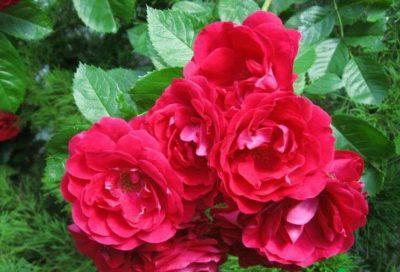

color;- size;
- form;
- smell.
There are about 60 plant species in our country. But frost-resistant varieties of flowers that can grow and winter in a harsh climate require special attention. Their total number is difficult to determine, because every year breeders breed all new types of roses that could survive at a temperature of -40 ° C.
Florist reviews
Alexrus
You can of course not cover the roses at all.In most cases, they will freeze at ground level, maybe even at the level of snow that fell before the first severe frosts.
Marlena
Not indifferent to the Bonica rose. I think you can try not to cover it in more northern regions. This is an unpretentious and grateful rose about 1x1.5. With brushes of cute colors. She and Fairy delight you until the frost.
How to care for roses outdoors in the Moscow region?
Roses are very demanding plants. They need good care. However, if all the recommendations for their cultivation are followed, then the queen of the garden will certainly thank you with beautiful flowers. First of all, the rose garden must be watered. This should be done abundantly, but once a week. The soil should be well moistened - by 25 centimeters.
Important! If the weather is hot outside, then the water rate is doubled, and irrigation is done twice a week.
After each watering, the bushes are recommended to mulch, this procedure will retain moisture in the soil for as long as possible.
Roses need feeding. The first two or three years they can not be fed, since during planting nutrients have already been introduced into the hole, which will be enough for the roses for this period. In the fourth year, it is already necessary to feed the rose bushes. This should be done at least twice during the growing season. For the first time, fertilizing is given with nitrogen fertilizers (the nitrogen content must be at least 70%). Nitrogen fertilization is done in late April-early May, even before the buds bloom. Roses are fed for the second time in early August. At this time, roses begin to prepare for winter, so they are fed with phosphorus-potassium fertilizers. They are responsible for a good overwintering of plants.
Watering in the rose garden will continue until late autumn. Moreover, in late September-early October, the bushes are given water-charging irrigation, the rate of which is twice or a second more than usual.
Factors affecting the ability of roses to withstand low temperatures
Even the most unpretentious roses feel much better in favorable growing conditions. No dispute, rose hips can grow on poor soilsbut in this case it will be fight for survival... In order for a rose to grow actively, bloom profusely and winter well, it is required:
- Fertile soil,
- Wind protection,
- Good lighting,
- Preventive care against diseases and pests.
Characteristics of the soil required for the successful growth of roses:
| Fertility | Above average. A sufficient amount of nutrients ensures full vegetative development and maturation of rose tissues. This directly affects its successful wintering. |
| Acidity | Affects the access of solutes... Optimal level pH = 6 - 7. |
| Structure | Medium loam. Sandy soils for roses are undesirable, since they freeze deeply in winter. Clay soils retain moisture, which negatively affects the roots of roses. |
When choosing a place on the site for roses that do not need to be covered for the winter, you should take care of protection from the wind. As the cold winter torrent freezes the bushes. Even frost-resistant varieties feel better in a cozy place (
What are the zones?
4 zones of winter hardiness - what is it? The winter hardiness zone is the climatic zone of the Earth where this or that plant can grow. They are based on average annual temperature indicators. Also indicate the minimum temperature values in certain areas. The most complete temperature scale in use today is called the USDA.
Russia is no exception, and is also divided into climatic zones. Some large cities belong to the following frost resistance indicators:
- Zone 1 - Batagay, Tiksi.
- Zone 2 - the main territory of the country, Novosibirsk, Krasnoyarsk, Yakutsk.
- Zone 3 - Magadan, Vorkuta.
- Zone 4 - Moscow, Moscow region, Ufa, Chelyabinsk.
- Zone 5 - St. Petersburg, Voronezh, Bryansk, Saratov.
- Zone 6.7 - Krasnodar.
Thus, nursery roses should be chosen adapted for zones 1-4 and partially 5.
Flowering period
As already stated, winter hardiness is a characteristic of various types of roses. And the start time and duration of flowering depends on a particular subspecies.
- Hybrid tea varieties bloom in several stages, from May to cold weather.
- Park roses usually bloom in the summer, around the end of May - June.
- Climbing can be pleasing to the eye from spring to autumn, but some varieties bloom once in early summer.
- Ground blooms bloom magnificently at the end of May, and the process lasts until the very frost.
The most resilient
Siberia is famous for its harsh climate. Not all plants can withstand such weather conditions: in winter the air temperature is up to -50 ° С, in summer up to + 30 ° С. Flowers, and even more so heat-loving roses, simply do not survive there.
Black magic
One of the most popular frost-resistant varieties of German breeders. Suitable for cutting. Can stand in a vase for more than three weeks. It is mainly produced for sale, but residents of colder regions use this variety to decorate their flower beds.

